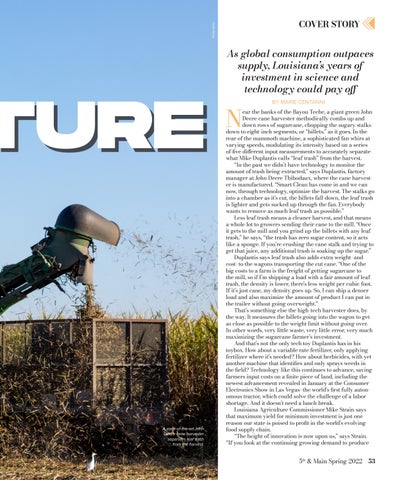Collin Richie
COVER STORY
LTURE
A state-of-the-art John Deere cane harvester separates leaf trash from the harvest.
As global consumption outpaces supply, Louisiana’s years of investment in science and technology could pay off
N
BY MARIE CENTANNI
ear the banks of the Bayou Teche, a giant green John Deere cane harvester methodically combs up and down rows of sugarcane, chopping the sugary stalks down to eight-inch segments, or “billets,” as it goes. In the rear of the mammoth machine, a sophisticated fan whirs at varying speeds, modulating its intensity based on a series of five different input measurements to accurately separate what Mike Duplantis calls “leaf trash” from the harvest. “In the past we didn’t have technology to monitor the amount of trash being extracted,” says Duplantis, factory manager at John Deere Thibodaux, where the cane harvester is manufactured. “Smart Clean has come in and we can now, through technology, optimize the harvest. The stalks go into a chamber as it’s cut, the billets fall down, the leaf trash is lighter and gets sucked up through the fan. Everybody wants to remove as much leaf trash as possible.” Less leaf trash means a cleaner harvest, and that means a whole lot to growers sending their cane to the mill. “Once it gets to the mill and you grind up the billets with any leaf trash,” he says, “the trash has zero sugar content, so it acts like a sponge. If you’re crushing the cane stalk and trying to get that juice, any additional trash is soaking up the sugar.” Duplantis says leaf trash also adds extra weight—and cost—to the wagons transporting the cut cane. “One of the big costs to a farm is the freight of getting sugarcane to the mill, so if I’m shipping a load with a fair amount of leaf trash, the density is lower, there’s less weight per cubic foot. If it’s just cane, my density goes up. So, I can ship a denser load and also maximize the amount of product I can put in the trailer without going overweight.” That’s something else the high-tech harvester does, by the way. It measures the billets going into the wagon to get as close as possible to the weight limit without going over. In other words, very little waste, very little error, very much maximizing the sugarcane farmer’s investment. And that’s not the only tech toy Duplantis has in his toybox. How about a variable rate fertilizer, only applying fertilizer where it’s needed? How about herbicides, with yet another machine that identifies and only sprays weeds in the field? Technology like this continues to advance, saving farmers input costs on a finite piece of land, including the newest advancement revealed in January at the Consumer Electronics Show in Las Vegas—the world’s first fully autonomous tractor, which could solve the challenge of a labor shortage. And it doesn’t need a lunch break. Louisiana Agriculture Commissioner Mike Strain says that maximum yield for minimum investment is just one reason our state is poised to profit in the world’s evolving food supply chain. “The height of innovation is now upon us,” says Strain. “If you look at the continuing growing demand to produce
5th & Main Spring 2022 53




